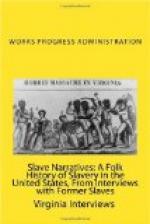The floors and chimneys on the Davis Plantation were made of wood and brick instead of dirt and mud as was the case on many of the other surrounding plantations. One window (with shutters instead of window panes) served the purpose of ventilation and light. At night pine knots or candles gave light. The little cooking that the slaves did at home was all done at the open fireplace.
Near the living quarters was a house known as the “chillun house.” All children too young for field work stayed at this house in the care of the older slave women. There was no hospital building on the premises. The sick had to remain in their individual cabins where they too were cared for by slaves too old for field work.
Only one family lived in a cabin. Mose’s mother and father each had a separate cabin. He did not explain the reason for this but said that he was made to live in his father’s cabin. Whenever he could, (usually when his father was away with the Colonel for a day or two) he stayed in his mothers cabin. “The only difference between the houses we lived in during slavery and those that some of us live in now who said is that we had more room there than we have now.” He says that even the community cook house was larger than some of the living quarters of today. All cabins were white washed the same as the other buildings on the plantation, and the occupants were required to keep the interiors and the surrounding clean at all times. The overseer’s cabin was located a short distance away from the slave cabins, so that it would be easier for him to keep check on his charges.
There was little if any sickness but Colonel Davis employed a doctor who visited the plantation each week. On other occasions the overseer administered such remedies as castor oil, turpentine, etc., and the slaves had remedies of their own. For stomach ache they used a tea made of Jimson weeds. Another medicine was heart leaf tea. Manual and religious training were the only types allowed on the plantation. Trades like carpentry, blacksmithing, etc. were learned from the white mechanics sometimes employed by Colonel Davis. All slaves were required to attend church and a special building was known as “Davis’ Chapel.” A Negro preacher officiated and no white people were present. Uncle Mose doesn’t know what was preached as he and Manning always slipped into town on Sundays to see the girls. Uncle Mose says he and Manning were together so much that occasionally they even slept in the same bed,—sometimes in Manning’s house and sometimes at his own house.
A pool for baptism was filled with well water. The colored pastor performed all baptisms and marriages.




